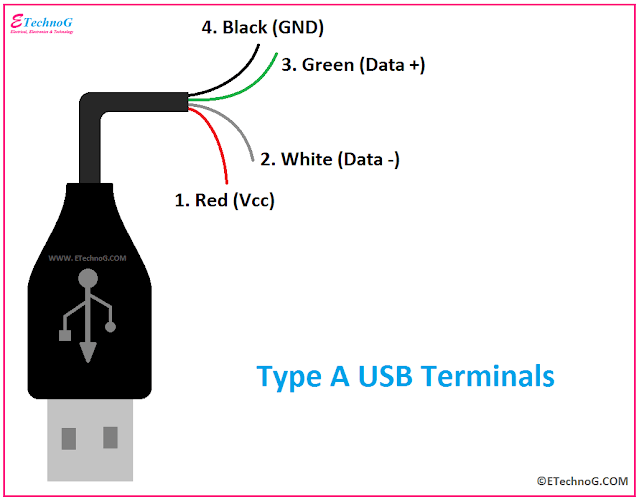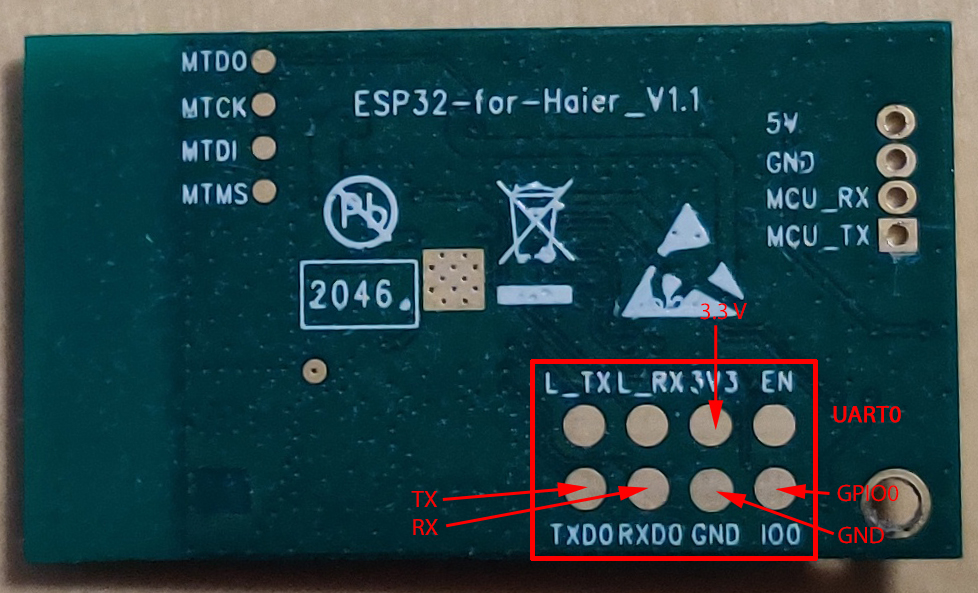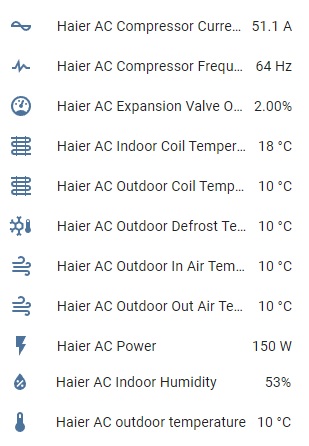This is an implementation of the ESPHome component to control HVAC on the base of the SmartAir2 and hOn Haier protocols (AC that is controlled by the hOn or SmartAir2 application).
There are two versions of the Haier protocol: the older version uses an application called SmartAir2 while the newer version uses an application called hOn. Both protocols are compatible on the transport level but utilize different commands to control appliances.
Older Haier models controlled by the SmartAir2 application are using the KZW-W002 module. This module can’t be reused, and you need to replace it with an ESP or RPI Pico W module. The USB connector on the board doesn’t support the USB protocol. It is a UART port that just uses a USB connector. To connect the ESP board to your AC you can cut a USB type A cable and connect wires to the climate connector.
| Board | USB | Wire color | ESP8266 |
|---|---|---|---|
| 5V | VCC | red | 5V |
| GND | GND | black | GND |
| TX | DATA+ | green | RX |
| RX | DATA- | white | TX |
Newer Haier models using a module called ESP32-for-Haier. It is an ESP32 single-core board with an ESP32-S0WD chip. In some cases, you can reuse this module and flash it with ESPHome, but some new modules don’t support this. They look the same but have encryption enabled.
Warning! The new generation of ESP32-Haier devices has encryption enabled, so they can only be flashed with firmware that is signed with a private key. There is no way to make them work with ESPHome, so if you try to do it, the board will get into a boot loop with the error rst:0x10 (RTCWDT_RTC_RESET),boot:0x13 (SPI_FAST_FLASH_BOOT) The only way to recover this board is to flash it with the original image. So before starting your experiments make a backup image.
Also, you can use any other ESP32, ESP8266, or an RPI pico W board. In this case, you will need to cut the original wire or make a connector yourself (the board has a JST SM04B-GHS-TB connector)
This component requires a UART Bus to be setup.
# Example configuration entry
climate:
- platform: haier
id: haier_ac
protocol: hon
name: Haier AC
uart_id: ac_port
wifi_signal: true
display: true
visual:
min_temperature: 16 °C
max_temperature: 30 °C
temperature_step: 1 °C
supported_modes:
- 'OFF'
- HEAT_COOL
- COOL
- HEAT
- DRY
- FAN_ONLY
supported_swing_modes:
- 'OFF'
- VERTICAL
- HORIZONTAL
- BOTH
supported_presets:
- AWAY
- BOOST
- SLEEP
on_alarm_start:
then:
- logger.log:
level: WARN
format: "Alarm activated. Code: %d. Message: \"%s\""
args: [ code, message]
on_alarm_end:
then:
- logger.log:
level: INFO
format: "Alarm deactivated. Code: %d. Message: \"%s\""
args: [ code, message]
on_status_message:
then:
- logger.log:
level: INFO
format: "New status message received, size=%d, subcmd=%02X%02X"
args: [ 'data_size', 'data[0]', 'data[1]' ]- uart_id (Optional, ID): ID of the UART port to communicate with AC.
- protocol (Optional, string): Defines communication protocol with AC. Possible values:
honorsmartair2. The default value issmartair2. - wifi_signal (Optional, boolean): If
true- send wifi signal level to AC. - answer_timeout (Optional, Time): Responce timeout. The default value is
200ms. - alternative_swing_control (Optional, boolean): (supported by smartAir2 only) If
true- use alternative values to control swing mode. Use only if the original control method is not working for your AC. - status_message_header_size (Optional, int): (supported only by hOn) Define the header size of the status message. Can be used to handle some protocol variations. Use only if you are sure what you are doing. The default value:
0. - control_packet_size (Optional, int): (supported only by hOn) Define the size of the control packet. Can help with some newer models of ACs that use bigger packets. The default value:
10. - sensors_packet_size (Optional, int): (supported only by hOn) Define the size of the sensor packet of the status message. Can help with some models of ACs that have bigger sensor packet. The default value:
22, minimum value:18. - control_method (Optional, list): (supported only by hOn) Defines control method (should be supported by AC). Supported values:
MONITOR_ONLY- no control, just monitor status,SET_GROUP_PARAMETERS- set all AC parameters with one command (default method),SET_SINGLE_PARAMETER- set each parameter individually (this method is supported by some new ceiling ACs like AD71S2SM3FA) - display (Optional, boolean): Can be used to set the AC display off.
- beeper (Optional, boolean): Can be used to disable beeping on commands from AC. Supported only by hOn protocol.
- supported_modes (Optional, list): Can be used to disable some of AC modes. Possible values:
'OFF',HEAT_COOL,COOL,HEAT,DRY,FAN_ONLY. - supported_swing_modes (Optional, list): Can be used to disable some swing modes if your AC does not support it. Possible values:
'OFF',VERTICAL,HORIZONTAL,BOTH. - supported_presets (Optional, list): Can be used to disable some presets. Possible values for smartair2 are:
AWAY,BOOST,COMFORT. Possible values for hOn are:AWAY,BOOST,SLEEP.AWAYpreset can be enabled only inHEATmode, it is disabled by default. - on_alarm_start (Optional, Automation): (supported only by hOn) Automation to perform when AC activates a new alarm. See on_alarm_start Trigger.
- on_alarm_end (Optional, Automation): (supported only by hOn) Automation to perform when AC deactivates a new alarm. See on_alarm_end Trigger.
- on_status_message (Optional, Automation): Automation to perform when status message received from AC. See on_status_message Trigger.
- All other options from Climate.
This automation will be triggered when a new alarm is activated by AC. The error code of the alarm will be given in the variable code (uint8_t), error message in the variable message (const char *). Those variables can be used in lambdas.
climate:
- protocol: hon
on_alarm_start:
then:
- logger.log:
level: WARN
format: "Alarm activated. Code: %d. Message: \"%s\""
args: [ 'code', 'message' ]This automation will be triggered when a previously activated alarm is deactivated by AC. The error code of the alarm will be given in the variable code (uint8_t), error message in the variable message (const char *). Those variables can be used in lambdas.
climate:
- protocol: hon
on_alarm_end:
then:
- logger.log:
level: INFO
format: "Alarm deactivated. Code: %d. Message: \"%s\""
args: [ 'code', 'message' ]This automation will be triggered when component receives new status packet from AC. Raw message binary (without header and checksum) will be provided in the variable data (const char *), message length in the variable data_size (uint8_t). Those variables can be used in lambdas.
This trigger can be used to support some features that unique for the model and not supported by others.
climate:
- protocol: hon
on_status_message:
then:
- logger.log:
level: INFO
format: "New status message received, size=%d, subcmd=%02X%02X"
args: [ 'data_size', 'data[0]', 'data[1]' ]This action turns AC power on.
on_...:
then:
climate.haier.power_on: device_idThis action turns AC power off
on_...:
then:
climate.haier.power_off: device_idThis action toggles AC power
on_...:
then:
climate.haier.power_toggle: device_idThis action turns the AC display on.
on_...:
then:
climate.haier.display_on: device_idThis action turns the AC display off.
on_...:
then:
climate.haier.display_off: device_idTurn on health mode (UV light sterilization).
on_...:
then:
climate.haier.health_on: device_idTurn off health mode.
on_...:
then:
climate.haier.health_off: device_id(supported only by hOn) This action enables beep feedback on every command sent to AC.
on_...:
then:
climate.haier.beeper_on: device_id(supported only by hOn) This action disables beep feedback on every command sent to AC (keep in mind that this will not work for IR remote commands).
on_...:
then:
climate.haier.beeper_off: device_id(supported only by hOn) Set direction for vertical airflow if the vertical swing is disabled. Possible values: Health_Up, Max_Up, Up, Center, Down, Health_Down.
on_...:
then:
- climate.haier.set_vertical_airflow:
id: device_id
vertical_airflow: Up(supported only by hOn) Set direction for horizontal airflow if the horizontal swing is disabled. Possible values: Max_Left, Left, Center, Right, Max_Right.
on_...:
then:
- climate.haier.set_horizontal_airflow:
id: device_id
vertical_airflow: Right(supported only by hOn) Start self-cleaning.
on_...:
then:
- climate.haier.start_self_cleaning: device_id(supported only by hOn) Start 56°C steri-cleaning.
Additional sensors for Haier Climate device. These sensors are supported only by the hOn protocol.
# Example configuration entry
sensor:
- platform: haier
haier_id: haier_ac
outdoor_temperature:
name: Haier outdoor temperature
humidity:
name: Haier Indoor Humidity
compressor_current:
name: Haier Compressor Current
compressor_frequency:
name: Haier Compressor Frequency
expansion_valve_open_degree:
name: Haier Expansion Valve Open Degree
indoor_coil_temperature:
name: Haier Indoor Coil Temperature
outdoor_coil_temperature:
name: Haier Outdoor Coil Temperature
outdoor_defrost_temperature:
name: Haier Outdoor Defrost Temperature
outdoor_in_air_temperature:
name: Haier Outdoor In Air Temperature
outdoor_out_air_temperature:
name: Haier Outdoor Out Air Temperature
power:
name: Haier Power- haier_id (Required, ID): The id of haier climate component
- outdoor_temperature (Optional): Temperature sensor for outdoor temperature. All options from Sensor.
- humidity (Optional): Sensor for indoor humidity. Make sure that your climate model supports this type of sensor. All options from Sensor.
- compressor_current (Optional): Sensor for climate compressor current. Make sure that your climate model supports this type of sensor. All options from Sensor.
- compressor_frequency (Optional): Sensor for climate compressor frequency. Make sure that your climate model supports this type of sensor. All options from Sensor.
- expansion_valve_open_degree (Optional): Sensor for climate's expansion valve open degree. Make sure that your climate model supports this type of sensor. All options from Sensor.
- indoor_coil_temperature (Optional): Temperature sensor for indoor coil temperature. Make sure that your climate model supports this type of sensor. All options from Sensor.
- outdoor_coil_temperature (Optional): Temperature sensor for outdoor coil temperature. Make sure that your climate model supports this type of sensor. All options from Sensor.
- outdoor_defrost_temperature (Optional): Temperature sensor for outdoor defrost temperature. Make sure that your climate model supports this type of sensor. All options from Sensor.
- outdoor_in_air_temperature (Optional): Temperature sensor incoming air temperature. All options from Sensor.
- outdoor_out_air_temperature (Optional): Temperature sensor for outgoing air temperature. All options from Sensor.
- power (Optional): Sensor for climate power consumption. Make sure that your climate model supports this type of sensor. All options from Sensor.
Additional sensors for Haier Climate device. These sensors are supported only by the hOn protocol.
# Example configuration entry
binary_sensor:
- platform: haier
haier_id: haier_ac
compressor_status:
name: Haier Outdoor Compressor Status
defrost_status:
name: Haier Defrost Status
four_way_valve_status:
name: Haier Four Way Valve Status
indoor_electric_heating_status:
name: Haier Indoor Electric Heating Status
indoor_fan_status:
name: Haier Indoor Fan Status
outdoor_fan_status:
name: Haier Outdoor Fan Status- haier_id (Required, ID): The id of haier climate component
- compressor_status (Optional): A binary sensor that indicates Haier climate compressor activity. All options from Binary Sensor.
- defrost_status (Optional): A binary sensor that indicates defrost procedure activity. All options from Binary Sensor.
- four_way_valve_status (Optional): A binary sensor that indicates four way valve status. All options from Binary Sensor.
- indoor_electric_heating_status (Optional): A binary sensor that indicates electrical heating system activity. All options from Binary Sensor.
- indoor_fan_status (Optional): A binary sensor that indicates indoor fan activity. All options from Binary Sensor.
- outdoor_fan_status (Optional): A binary sensor that indicates outdoor fan activity. All options from Binary Sensor.
Additional sensors for Haier Climate device. These sensors are supported only by the hOn protocol.
# Example configuration entry
text_sensor:
- platform: haier
haier_id: haier_ac
appliance_name:
name: Haier appliance name
cleaning_status:
name: Haier cleaning status
protocol_version:
name: Haier protocol version- haier_id (Required, ID): The id of haier climate component
- appliance_name (Optional): A text sensor that indicates Haier appliance name. All options from Text Sensor.
- cleaning_status (Optional): A text sensor that indicates cleaning status. Possible values "No cleaning", "Self clean", "56°C Steri-Clean". All options from Text Sensor.
- protocol_version (Optional): A text sensor that indicates Haier protocol version. All options from Text Sensor.
Additional buttons for Haier AC cleaning. These buttons are supported only by the hOn protocol.
# Example configuration entry
button:
- platform: haier
haier_id: haier_ac
self_cleaning:
name: Haier start self cleaning
steri_cleaning:
name: Haier start 56°C steri-cleaning- haier_id (Required, ID): The id of Haier climate component
- self_cleaning (Optional): A button that starts Haier climate self cleaning. All options from Button.
- steri_cleaning (Optional): A button that starts Haier climate 56°C Steri-Clean. All options from Button.
Additional switches to support additional features for Haier AC.
# Example configuration entry
switch:
- platform: haier
beeper:
name: Haier beeper
health_mode:
name: Haier health mode
display:
name: Haier display
quiet_mode:
name: Haier quiet mode- haier_id (Required, ID): The id of Haier climate component
- beeper (Optional): (supported only by hOn) A switch that enables or disables Haier climate sound feedback. All options from Switch.
- health_mode (Optional): A switch that enables or disables Haier climate health mode (UV light sterilization). All options from Switch.
- display (Optional): A switch that enables or disables Haier climate led display. All options from Switch.
- quiet_mode (Optional): (supported only by hOn) A switch that enables or disables Haier climate quiet mode. Quiet mode not supported in Fan only mode. All options from Switch.
It is strongly recommended to make a backup of the original flash content before flashing ESPHome!
To make a backup and to flash the new firmware you will need to use a USB to TTL converter and solder wires to access UART0 on board (or use something like this: Pogo Pin Probe Clip 2x5p 2.54 mm)
UART0 pinout:
To put the device in the flash mode you will need to shortcut GPIO0 to the ground before powering the device.
Once the device is in flash mode you can make a full backup of the original firmware in case you would like to return the module to its factory state. To make a backup you can use esptool. Command to make a full flash backup:
python esptool.py -b 115200 –port read_flash 0x00000 0x400000 flash_4M.bin
After this, you can flash firmware using ESPHome tools (dashboard, website, esphome command, etc) .. Generated from additional_information.rst
- FAQ
- HaierProtocol
- Haier smart modules
- Haier protocol overview
- Example of climate configuration for smartair2 protocol
- Example of climate configuration for hOn protocol
- ESPHome Haier Climate
- ESPHome Haier Climate Sensors
- ESPHome Haier Climate Binary Sensors
- Esptool.py Documentation
- Sniffing serial communication



